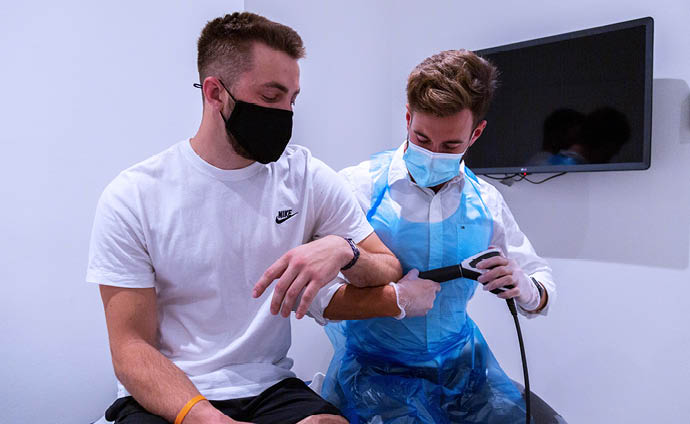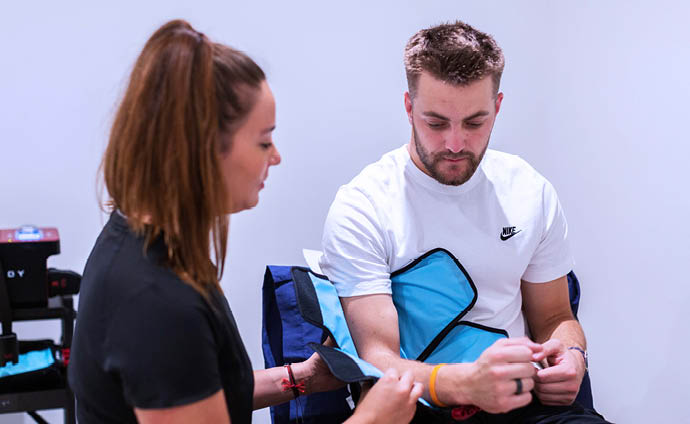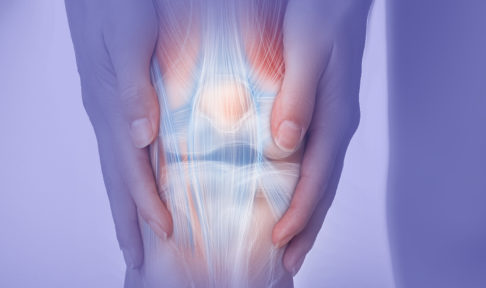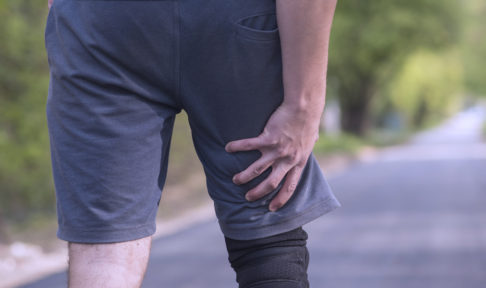Golfer’s elbow is one of those funny conditions that, despite the name, can affect anyone, regardless of whether they play golf or not! Medically known as medial epicondylopathy, golfer’s elbow is an injury of the tendons on the inside of the elbow, normally due to overloading through repetitive movements that cause strain to the area.
So, how can you tell if the pain you’re experiencing in your elbow might be golfer’s elbow, tennis elbow, or something else entirely? A trip to see a physio at Spectrum for a proper assessment is the most accurate way to know for sure, but if you’re looking for some general info, the following is a good start.
What are the symptoms of golfer’s elbow?
Simply put, golfer’s elbow basically refers to pain on the inside of the elbow. If you use your fingers to feel the side of your elbow closest to your body, you’ll feel a pointed bone sticking out, which is the attachment site for your tendons. Any damage to this area will cause pain in the elbow, which can also sometimes radiate up and down the arm, all the way to the wrist and in extreme cases, maybe even into the fingers. Wrist, hand or finger weakness, numbness or tingling is also possible. Other symptoms can include stiffness in the elbow or even a deterioration of the strength of your hand grip.
But I’m not a golfer, so how could I have golfer’s elbow?
As mentioned earlier, the causes of golfer’s elbow are not only applicable to people who play golf. Golfer’s elbow is caused by any repeated movements that create strain in this particular part of the elbow, especially forceful wrist or finger movements. But funnily enough, it’s not just large, awkward movements like the swinging of a golf club that can be problematic — poor desk setup or even bad posture for prolonged periods can be a cause in some cases. Unlike tennis elbow, golfer’s elbow is rarely caused by inflammation but instead is to do with damage or degeneration of the tendon itself that connects into the inside of the elbow.
How is golfer’s elbow treated by a physio?
The golden rule at Spectrum is assess before you treat, so if you present to us with elbow pain we won’t make any assumptions about the diagnosis unless we’ve undertaken a full assessment first. Once we have factored in your personal circumstances and any unique aspects of your body, will we thendevise a customised treatment plan to suit your body, injury and recovery goals. In the past it was common for practitioners to treat golfer’s elbow using steroid injections, but nowadays it is generally agreed that this is not the best course of treatment. Here are some of the therapies we would normally use instead:

Unlike many other clinics that will need to refer you elsewhere, we offer Shockwave therapy in our London clinic, and include it in our usual appointment cost. But when it comes to treating golfer’s elbow, we don’t just use the Shockwave machine in isolation, instead we combine it with specific exercises to speed up the healing process as much as possible.
Learn more about how Shockwave therapy works.

GameReady is a unique technology designed to quickly reduce inflammation and fast-track the healing process of the injured part of your arm or elbow. Much like Shockwave, it is easily accessible in our London clinic and the cost is included in our normal appointment cost too.
Learn more about how GameReady works.
Once we have utilised Shockwave and GameReady technology, we will generally progress you to another round of exercises (different to the ones used in conjunction with Shockwave). These exercises are specifically designed to correct biomechanical insufficiencies that are unique to golfer’s elbow. One way that we do this is to assess you using a series of ‘holds’, which are a type of exercise that includes twisting or pushing on your hand in different directions to see which ‘hold’ hurts, to help us determine exactly which exercises will benefit you most. When it comes to golfer’s elbow, often it will be the motion of twisting your arm down so that the palm of your hand is facing the floor that will hurt the most.
How long does golfer’s elbow take to heal?
Obviously, every case is different, depending on the severity of your condition, how well you can remove or reduce the movements that have caused it, and of course, how quickly you seek treatment from a physio, but on average golfer’s elbow symptoms will linger for between three and six months before they are entirely gone.
So why not book in and see us, so that you’re much closer to three (or even shorter!) than six months before you’re back to full health?
Book your appointment with one of our qualified physios and put a stop to your elbow pain for good.



